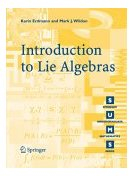Introduction to Lie Algebras, by Karin Erdmann and me, was published in 2006. It is based on 4th year courses given by the authors in Oxford. As such, it is particularly aimed at 3rd and 4th year undergraduates, but we hope it will be useful to anyone who wants a gentle introduction to the subject.
The approach is very elementary. The only prerequisite knowledge needed is some linear algebra, most of which is summarised in an appendix. Numerous examples are given, including a classification of all 3-dimensional complex Lie algebras. The root space decompositions of the classical Lie algebras are worked out in detail. The final chapter on further directions includes brief discussions of the representation theory of semisimple Lie algebras, finite groups of Lie type, Kac–Moody Lie algebras and the restricted Burnside problem.
From the end of Aloysius Helminck's review for MathSciNet:
Overall this book is a very well thought out and well-written introduction to Lie algebras and it provides an excellent entry point into Lie theory for advanced undergraduates and early graduate students interested in learning about the subject.
From Mark Hunacek's review for the Mathematical Gazette 92 no. 524 (2008) p382:
Erdmann and Wildon's book is more leisurely and chatty, and to my knowledge is the most readable and accessible account of this material that is currently in print. … In addition, the final chapter of the text entitled ‘Further Directions’ provides a number of (frequently expository and informal) discussions of more advanced topics. The sections of this chapter seemed written at just the right level of informality … In summary, I think this text may be the best pedagogical advance in the teaching of Lie algebras in the last few decades, and may in fact be the only textbook … genuinely suitable for undergraduates.
The authors would be grateful to hear of any errors or suggestions for improvements. Here is the current errata (last updated February 2020). The reprinted 1st edition, published June 2007, includes most of these corrections.
